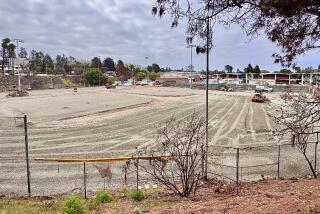Part of School Playground Closed Because of Leaking Gas
- Share via
Part of the playground at Bell Junior High School in Paradise Hills has been closed because of leaking methane gas, officials said Wednesday.
Douglas Adams, safety coordinator for the San Diego Unified School District, said the leakage poses no immediate hazard to students or nearby residents but that the county will continue to monitor the playground and neighboring areas indefinitely.
The site of the school, at 620 S. Briarwood in East San Diego, was used for a sanitary landfill from 1963-66, Adams said, and, from time to time since the school’s opening in 1967, “people have noticed a BO smell.”
“That’s the odor caused by the deterioration of organic matter underneath the ground,” he said. “As that decomposes, gases are released; that includes methane gas.
“Methane can’t be smelled, but, as it’s being released, it forms in pockets and can become an explosive hazard,” Adams said. “If the levels become high enough, yes, it can explode.”
Adams said the explosive limit of methane is considered to be 40,000 parts per million. District and county officials became alarmed Friday after a methane reading of 65,000 parts per million was recorded on the lower playground. Until then, the highest reading recorded in the area was 1,200 ppm, Adams said.
“In a wide-open area where there’s constant air movement, there’s not much chance of an explosion,” he said, adding that county air-pollution control engineers are now in charge of supervising and patrolling the site. “We’re concerned that in homes or nearby buildings,” pockets of methane might reach explosive limits, he said. “But, at the moment, we’re not picking up detectable levels.”
Dave Kotnik, vice principal of 2,400-student Bell, which includes grades seven through nine, said coaches and students had complained recently of odors emanating from the ground.
Only the lower playground was closed Friday, and all other areas of the school remain open, he said.
“The county was getting inconsistent results in tests conducted last week,” Kotnik said. “They should get more information in the next two weeks. It’s definitely their problem. It’s not a city schools problem. We don’t feel there’s any real concern on the part of students or staff.”
Asked why the school was built on a landfill site, Adams said, “That’s the question, but one I can’t answer.”
He explained that methane forms as heat is generated inside the underground landfill. The heat intensifies with the growth of bacteria, and rain accelerates that growth, causing the methane to seep up through the ground.
Meters have been in place around the school to alert officials if gas concentrations become high enough to trigger an explosion, Adams said. He said that the county hopes to hire a consultant to propose a system to extract and burn off the methane, and that the system could be in place by summer.
More to Read
Sign up for Essential California
The most important California stories and recommendations in your inbox every morning.
You may occasionally receive promotional content from the Los Angeles Times.













